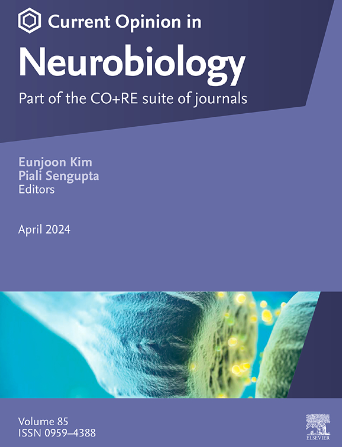统计规律和自我行为的感觉后果:一个多物种,多模态的视角
IF 5.2
2区 医学
Q1 NEUROSCIENCES
引用次数: 0
摘要
主动感知是许多生物体生存的必要条件。虽然自然场景中的统计规律以及生态相关性与塑造运动行为特别相关,但对于这些因素如何额外影响大脑对自我行为的感觉后果的补偿机制,我们知之甚少。在这里,我们使用不同的感觉方式、物种和时间尺度,回顾了最近的研究进展,表明状态估计和感觉门控(运动过程中与感觉加工相关的基本功能)都是可塑的,并反映了统计规律。这种规律既存在于自然环境中,也存在于特定动作类型的感觉-运动偶然事件中。在一些物种和模式中,状态估计的机制已经很好地表征了,而在另一些物种中,感觉门控则更加发达。我们提供了一种比较方法,不仅确定了共同的基本原理,而且还强调了与每种感官形态和物种相关的即将到来的研究问题。本文章由计算机程序翻译,如有差异,请以英文原文为准。
Statistical regularities and the sensory consequences of self-action: A multi-species, multi-modal perspective
Active sensing is integral for survival in many organisms. While statistical regularities in natural scenes, as well as ecological relevance, are particularly relevant for shaping motor behaviors, significantly less is known about how these factors additionally influence the brain's compensatory mechanisms for the sensory consequences of self-action. Here, using different sensory modalities, species, and timescales, we review recent developments demonstrating that both state estimation and sensory gating, fundamental functions related to sensory processing during movement, are malleable and reflect statistical regularities. Such regularities exist in both the natural environment as well as in the sensory-motor contingencies specific to a given action type. In some species and modalities, the mechanisms for state estimation are well characterized, whereas in others, sensory gating is more developed. We provide a comparative approach that not only identifies common underlying principles, but also highlights upcoming research questions that are relevant for each sensory modality and species.
求助全文
通过发布文献求助,成功后即可免费获取论文全文。
去求助
来源期刊

Current Opinion in Neurobiology
医学-神经科学
CiteScore
11.10
自引率
1.80%
发文量
130
审稿时长
4-8 weeks
期刊介绍:
Current Opinion in Neurobiology publishes short annotated reviews by leading experts on recent developments in the field of neurobiology. These experts write short reviews describing recent discoveries in this field (in the past 2-5 years), as well as highlighting select individual papers of particular significance.
The journal is thus an important resource allowing researchers and educators to quickly gain an overview and rich understanding of complex and current issues in the field of Neurobiology. The journal takes a unique and valuable approach in focusing each special issue around a topic of scientific and/or societal interest, and then bringing together leading international experts studying that topic, embracing diverse methodologies and perspectives.
Journal Content: The journal consists of 6 issues per year, covering 8 recurring topics every other year in the following categories:
-Neurobiology of Disease-
Neurobiology of Behavior-
Cellular Neuroscience-
Systems Neuroscience-
Developmental Neuroscience-
Neurobiology of Learning and Plasticity-
Molecular Neuroscience-
Computational Neuroscience
 求助内容:
求助内容: 应助结果提醒方式:
应助结果提醒方式:


